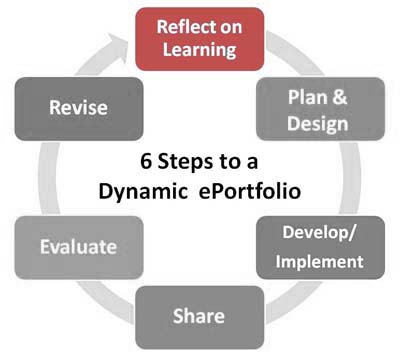
Structural Elements:
- Student Information: name, contact information, major, minor, graduation date, etc. The student's name and email should be available on each and every page of a well-designed eportfolio regardless of the purpose of the document.
- Navigation (Table of Contents) and/or index: You need to ensure that viewers of your eportfolio can find the information they seek with as few as 3 -5 clicks of their mouse. Every page should have a navigation bar either across the top of the page or along the either the left or right side of the page.
- An introductory or personal statement: The home page or landing page should include include a well-written statement describing the purpose of the eportfolio.
- Curricular standards and/or criteria: Include learning outcomes, accreditation standards, and/or general education requirements for the respective course or courses. Reference the course or curriculum requirements as you add documents and reflect on the learning achieved.
- Self-reflection/self assessment Blog: This is a critical and essential aspect of the developmental eportfolio. The self-reflection should occur across the duration of the course and/or curriculum that is the focus of the eportfolio. Include the learning outcomes, standards, and/or requirements that are relevant to the topic and/or assignment, particularly when you are reflecting.
- Rubrics: Many instructors now utilize rubrics to inform students of expectations and to analyze the student's assignment submission. Rubrics include a criteria-rating scale, which not only evaluate student performance they provide students with the information necessary to complete an effective self-assessment.
- Artifacts: Depending on the purpose of the developmental eportfolio, the student should provide a series of examples to illustrate their progression over time. The developmental or formative eportfolio stresses indications of growth and/or improvement. Therefore, students should be encouraged to revise and improve documents following peer or instructor reviews. The examples of student work (artifacts) might include word processing documents, images, illustrations, charts, spreadsheets, video, audio, etc. stresses “symptoms of growth,” For example, a first draft or outline for an essay would be followed by the instructor's and/or peer feedback. After revision, a second draft would be posted followed by the instructor's review and graded rubric. The final document would include the revised essay demonstrating your ability to argue a claim or position supported by citations and references.
- Instructor and Peer Feedback: When a student posts their eportfolio on the web, the eportfolio will be accessible to a much wider audience than a traditional assignment. An online survey (an abreviated rubric) can be utilized to provide peers and the instructor an opportunity to share insight and comments on documents. In the formative or developmental eportfolio, it is important the instructor fosters a student-friendly “positive learning environment” rather than a “grading environment.” Since the focus is on development, peer and instructor's feedback can serve to motivate a student to improve their documents to showcase their growth and improvement.









 RSS Feed
RSS Feed